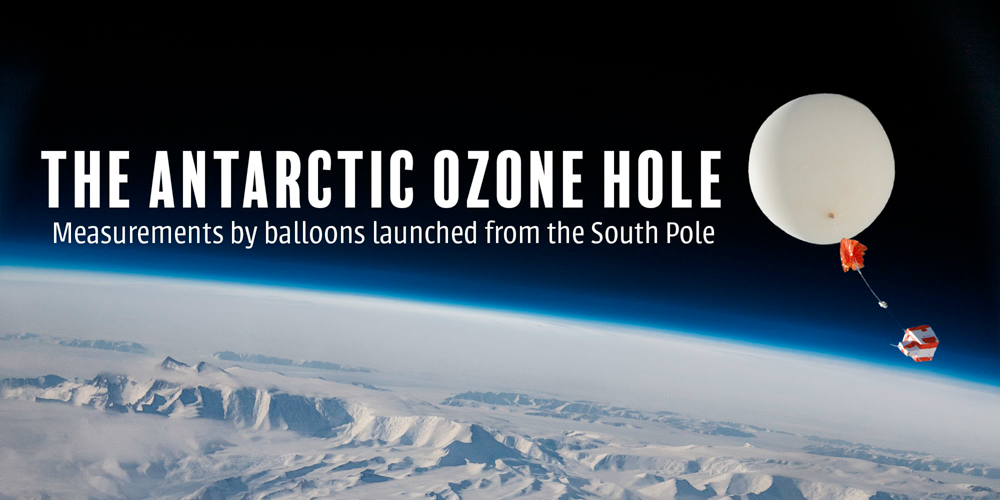
By Patrick Cullis, CIRES and NOAA scientist
The Ozone Layer protects life on Earth by filtering out harmful ultraviolet (UV) radiation from the sun that is a primary cause of skin cancer and cell damage in plants and animals. In the 1970’s scientists linked chlorofluorocarbons (CFCs) developed for use in air conditioners and aerosol spray cans to an accumulation of stratospheric chlorine, a serious threat to worldwide ozone destruction. In 1978 the Montreal Protocol was adopted as the framework for international cooperation regarding control of CFCs. Then, in 1985 the Ozone Hole was discovered above Antarctica, highlighting the seriousness of the danger posed by the continued production of CFCs. The following year, continuous monitoring of ozone by balloons began at the South Pole Station.

As summer comes to an end in the northern hemisphere, the sun is only beginning to return to the skies above Antarctica. Throughout the long, dark winter, unique ice crystals will form in the unusually cold temperatures inside the “Polar Vortex.” These ice crystals are known as Polar Stratospheric Clouds, or PSCs, and they allow the release of enormous amounts of destructive chlorine directly in to the protective ozone layer. With the added energy of the rising sun, this free chlorine devastates the ozone layer and forms the now-annual Ozone Hole.
Every spring an ozone hole forms over Antarctica. Instruments flown on balloons launched year round from the South Pole Station measure ozone and temperature from the surface to a height of about 100,000 feet. The left graph shows ozone destruction within the ozone layer occurring during spring. The breakup of the ozone hole is shown when large amounts of ozone pour in at high altitudes.
Measuring Ozone in the Atmosphere

The majority of ozone in the atmosphere is found high above the surface in the “Ozone Layer.” Stratospheric ozone is typically measured as Total Column Ozone, a number representing all the ozone molecules located in a column of air extending from the surface all the way to the edge of the atmosphere. The higher the total column ozone number, the more molecules of ozone overhead, and the more protection from UV radiation.
Land based instruments such as the Dobson Spectrophotometer measure ozone by looking at sunlight and wavelengths specifically filtered by ozone in order to determine a Total Column Ozone value.
Satellite instruments look at light reflected off the surface of Earth in a similar fashion to ground based measurements.

Ozonesonde Instrument
NOAA uses small electrochemical ozonesondes to measure ozone from the surface to over 100,000 feet. These instruments use a small electrical pump to bubble air through a solution of potassium iodide to convert ozone in to an electrical current that is measured once per second and then transmitted back to a ground station. This allows high resolution profiles of vertical ozone, allowing scientists and researchers to know exactly where ozone is distributed throughout the atmosphere. Also, unlike satellites and ground based instruments, ozonesondes do not require sunlight to measure ozone concentrations, making them the only instrument able to produce high quality measurements of the ozone layer during the darkness of winter and during the early formation of the annual ozone hole.
A six image sequence of a rubber balloon bursting at over 100,000 feet.
During the summer, NOAA scientists launch their ozonesondes on large rubber-latex balloons that rise to over 100,000 feet above the surface. The balloons stretch as the helium expands in the thinning atmosphere until they finally explode in a shred of biodegradable latex. A parachute slows the instrument on the way back down.
Launching a large plastic balloon from the South Pole.
As soon as the sun sets for 6 consecutive months of darkness during winter, they must switch to launching large plastic balloons. The plastic balloons do not stretch, but instead are filled with a small portion of helium which will expand to completely fill the balloon as the air pressure drops high in the atmosphere. Eventually, the balloon reaches its limit and bursts. Falling back to earth on a small parachute the instrument collects a second verification profile before gently landing back on the ground.
